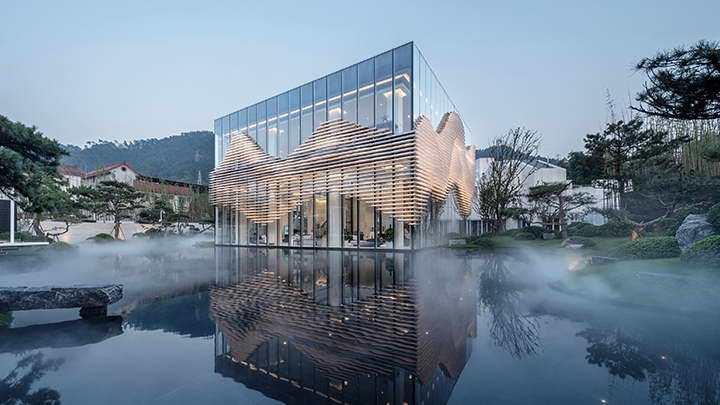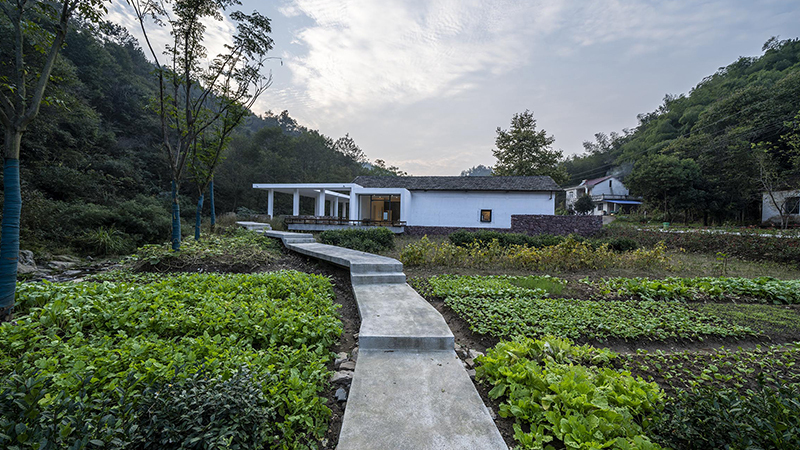天府之国成都有着4500年文明史、2300年建城史。13世纪,马可波罗的足迹来到了成都府,廊桥、锦江、蜀布成为他游记中浓墨重彩的一笔,21世纪,在“一带一路”倡议的大背景下,成都天府文创城的规划营运而生,而中意文化交流中心正是其中重要的组成部分,旨在搭建两国文化交流、文明互通的平台。
Chengdu hailed as the land of abundance, has a civilization history of 4,500 years old and a city construction history of 2,300 years old. In the 13th century, Marco Polo came to Chengdu, the Corridor Bridge, the Jinjiang River and the cloth of ancient Sichuan became the most colorful parts of his travelogue. In the 21st century, against the background of the Belt and Road Initiative, the planning of Chengdu Tianfu Cultural and Creative City came into being, and the Sino-Italian Cultural Exchange City Reception Center is an important part of the City, aiming to build a platform for cultural exchange and civilization interchange between the two countries.
项目规划占地约26.72亩,建筑面积约2106.7平方米。选址距离成都市中心约36公里,位于文创10路北侧,紧邻天府大道,展示度好,展厅平台可对望东侧创意组团项目以及雁栖湿地自然景观。
The project is located about 36 kilometers from the center of Chengdu, planned to cover an area of 17,815 square meters, with a construction area of 2,107 square meters. At the platform of the exhibition hall, the creative group projects on the east side and the natural landscape of Yanqi Wetland are treats for visitors.
设计之初,建筑师在希望在中西文化差异的形态中找到两者的交点:总体设计概念取自我国自古用以馈赠外国使臣的“如意”,以示缔结友好关系,寓意两国国泰民安。而意大利馆则从意大利最具代表性的广场中汲取设计灵感,塑造一个体量亲切、尺度宜人的城市艺术客厅。从古罗马的拱券、穹顶中提取设计元素,用多个圆形广场的流畅围合串联成丰富多变的使用空间,满足展览、会务、接待、餐饮等多功能要求。
The architects hoped to find the intersection of the two in the cultural differences between the East and the West: the overall design concept was taken from the "Ruyi", which has been used in China since ancient times as a gift to foreign ambassadors to signify the conclusion of friendly relations and the peace of the two countries; while the Italian pavilion draws its design inspiration from Italy's most representative piazza, shaping an intimate and pleasantly scaled urban art living room.
墙面通体使用纯粹的白色,使建筑在阳光下演绎出别样的立体光影效果,而玻璃的大面积使用,让室内空间向外无限延伸,也让室外景致全然映射进来,成为动态的四季壁画。设计师借由墙面材料的变化,营造出虽内犹外、亦内亦外的空间感受,展馆由此完美融入到周围的自然环境之中。内依旧是内,外依旧是外,但精神上的感受与渴望,内外无界。
The design elements are extracted from the ancient Roman arches and domes, and the smooth enclosure of multiple circular squares is used to form a rich and versatile use of space to meet the multi-functional requirements of exhibition, meeting, reception, and catering. The use of pure white on all walls gives the building a different three-dimensional light effect in the sunlight, while the large area of glass extends the indoor space to the outside and allows the outdoor scenery to be fully mapped in, becoming a dynamic mural of the four seasons. With the change of wall materials, the designer creates the feeling of space that is both inside and outside, and the pavilion is thus perfectly integrated into the surrounding natural environment.
建筑与自然和谐统一,在于对自然资源的使用,也在于对自然环境的保护。两侧的展馆均设计了顶部采光,使得光线均匀的弥散在室内外空间。此外,多层次室外绿色植物的引进,及利用浮力通风装置将气流导入建筑,将光、景、风的自然元素有机地结合起来,让人身在其中,亦可感知周围自然环境并与之共存。
The harmony between architecture and nature lies in the use of natural resources as well as in the protection of the natural environment. The pavilions on both sides are designed with top lighting so that the light is evenly diffused in the indoor and outdoor spaces. In addition, the introduction of multi-level outdoor greenery and the use of buoyant ventilation devices to channel airflow into the building organically combine the natural elements of light, scenery, and wind, allowing people to perceive and coexist with the surrounding natural environment while they are in the building.
同时,建筑设计尊重既有的生态环境,采用low-e玻璃、本地木材、屋顶绿植等材料和手段降低建筑能耗,实现可持续建造。展示馆作为串联、整合周围生态林盘的重要节点。
Meanwhile, the building design reveres the existing ecological environment and uses materials and means such as Low-E glass, local wood, and green roofs to reduce building energy consumption and achieve sustainable construction. The exhibition hall serves as an important part for linking and integrating the surrounding ecological forest.
空间规划方面,设计师预留了最大弹性布展展示空间,建筑高低错落的设计让访客站在不同高度观览不同的景致,营造出“漫步林间”的意境,产生独特的游览感受。
In terms of space planning, the designer has reserved the most flexible space for exhibition and display. The staggered height of the building allows visitors to stand at different heights and view different scenery, creating a "walk in the woods" mood and a unique experience.
建筑室内是由10个大小各异的圆形墙面塑造的流动空间,顺应地势分3级标高,从入口大厅向内部空间逐级抬升,入口大厅及中央展厅分设2处圆形天窗,光线引导访客由入口大厅步入主展厅。
The interior of the building is a flowing space shaped by 10 circular walls of different sizes, which are divided into three levels of elevation in accordance with the terrain, rising from the entrance hall to the interior space step by step, with two circular skylights in the entrance hall and the central exhibition hall to guide visitors from the entrance hall to the main exhibition hall. The ceiling is controlled at the same level, and the height of the space is richly varied. Except for the round solid wall, the interior and exterior boundaries are all glass, fully incorporating the outdoor landscape into the interior and the natural landscape as part of the exhibition in the form of framed scenery.
圆形空间由室内和广场两种空间形态组成。3个室外半圆形广场定义为入口喷泉广场,意大利广场,室外剧场,分别再现典型的意大利城市广场空间。意大利广场由罗马拱圈废墟环绕而成。
The circular space consists of two spatial forms: indoor and piazza; three outdoor semi-circular piazzas are defined as the entrance fountain piazza, the Italian piazza, and the outdoor theater, each reproducing a typical Italian urban piazza space. The Piazza Italia is surrounded by the ruins of the Roman arches.
访客穿越檐廊到达意大利广场,沿弧形楼梯拾级而上,到达屋顶花园。其间分设两处圆形花园,花园通过自然植被与石材的对比,一东一西,相得益彰。拾级而下,穿越文化长廊,或踏过水塘之上的汉白玉步汀,到达东侧中华文化馆。两条路径寓意东西方之间,陆地和水上的两条丝绸之路。
The visitor crosses the gable to the Italian piazza and ascends a curved staircase to the roof garden. There are two circular gardens, one in the east and one in the west, which are complemented by the contrast between natural vegetation and stone. The Chinese Cultural Hall on the east side is reached by walking down through the cultural corridor or stepping over the Chinese white jade pavement above the water pond. The two paths symbolize the two Silk Roads between East and West, on land and on water.
Project Name: Sino-Italian Cultural Exchange City Reception Center
Architecture Firm: aoe
Website: www.aoe-china.com
Contact e-mail: chang.qi@aoe-china.com
Firm Location: Beijing, China
Construction Status: Completed
Design Period: 06.2020-09.2020
Construction Period: 09.2020-04.2021
Site Area: 17814.6 sqm
Site Coverage: 8.4%
Gross Floor Area: 1695.8 sqm
Landscaping Ratio: 66%
Building height: 13.55 m
Project location: Chengdu, China
Lead Architects
Wen Qun
larry.wen@aoe-china.com
Additional Credits
Design Team: Ma Jianning, Fan Ruixue, Wang Ye, Chang Zhiyu, Pan Jichang, Li Xiangting, Lu Yu
Interior:Zhu Dan, Du Jing, Liu Jingyi, Xue Yawen, Liu Chen
Clients: Tianfu Investment Group Co., LTD
Structure Engineer: CSCEC AECOM CONSULTANTS CO., LTD
Photo Credit: Arch-exist
更新日期:2021-04-26 16:35:44
非常感谢 事建组 带来的精彩项目, 查阅更多Appreciations towards aoe for sharing wonderful work on hhlloo. Click to see more works!




















